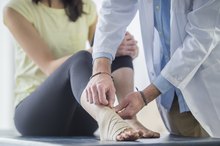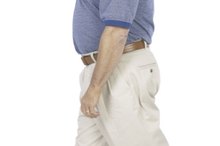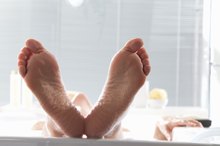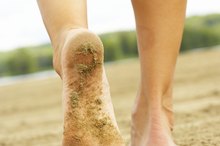What does fact checked mean?
At Healthfully, we strive to deliver objective content that is accurate and up-to-date. Our team periodically reviews articles in order to ensure content quality. The sources cited below consist of evidence from peer-reviewed journals, prominent medical organizations, academic associations, and government data.
The information contained on this site is for informational purposes only, and should not be used as a substitute for the advice of a professional health care provider. Please check with the appropriate physician regarding health questions and concerns. Although we strive to deliver accurate and up-to-date information, no guarantee to that effect is made.
Is There a Natural Way to Get Rid of Fluid in the Body?
Having excess fluid trapped in your body’s tissues is a condition known as edema. Although edema most frequently occurs in the arms, hands, legs, ankles and feet, it can also occur in other areas of the body. Common signs of edema include swollen limbs, bloating in the abdomen, muscle aches and a puffy face. Some edema cases require medical treatment, but you may also be able to get rid of the excess fluid with a few natural self-care methods. Talk to a doctor if your edema seems severe or does not resolve on its own.
Exercise during the day. Any extra movement, especially in the area of your body affected by fluid retention, may help you pump the excess fluid back in the direction of your heart. Aim for at least 30 minutes of physical activity a day, but also avoid sitting or standing still for more than 30 minutes without getting up at least once to stretch, have a drink of water or simply move a bit.
What Can I Eat or Drink to Reduce Swelling in My Feet & Ankles?
Learn More
Elevate the affected limbs. Keeping the swollen area above heart level for at least 30 minutes three to four times per day may help return some of the fluid to your heart. As an example, roll up a towel or place a pillow under your legs when watching TV or sleeping, recommends the Cleveland Clinic 2.
Put down the saltshaker and limit caffeine and alcohol. Sodium can lead to fluid retention, so avoid adding salt to cooked foods and cut out foods or condiments that are already high in sodium 3. Some examples include soy sauce, deli meats and canned soups and vegetables. Ask your doctor for extra advice on limiting your sodium intake. Caffeine and alcohol can also lead to fluid retention, so also cut down on or eliminate coffee, tea, caffeinated sodas and alcoholic beverages 3. Focus on drinking water and eating mostly plant-based foods such as whole grains, seeds and nuts, fruits and vegetables to help you naturally cut down on salt, alcohol and caffeine.
Ways to Help Water Retention in Your Legs
Learn More
Keep your body temperature steady. Sudden extreme temperature shifts can worsen edema, so dress warmly in cold temperatures, avoid hot baths and saunas, and keep your skin protected from sunburn.
Invest in compression stockings, gloves or sleeves. Compression articles maintain steady pressure on affected limbs to prevent fluid from accumulating in the tissue. Purchase them at your local drugstore, but consult your doctor if you have trouble finding the appropriate garment.
Apply firm pressure while stroking the affected area toward the direction of your heart. This aids fluid in moving toward your heart. Another way to help move fluid in the appropriate direction is to briskly brush your skin surface with a soft brush or rough washcloth prior to bathing, beginning at your feet and working your way up in the direction of your heart.
Tips
Because persistent edema may be a sign of an underlying health problem, you may need to seek medical help if home care doesn’t result in reduced fluid retention. Your doctor may need to medicate the underlying problem or he may prescribe diuretics, medicines specifically designed to reduce fluid levels in your body.
Related Articles
References
- MedlinePlus: Edema
- Cleveland Clinic: Edema
- Cancer.net: Edema or Fluid Retention
- Adukauskiene D, Bivainyte A, Radaviciūte E. Cerebral edema and its treatment. Medicina (Kaunas). 2007;43(2):170-6.
- Cleveland Clinic. Edema.
- Ely, JW, Osheroff JA, Chamblis ML, et al. Approach to Leg Edema of Unclear Etiology. J Am Board Fam Med March 2006, 19 (2) 148-160; DOI: 10.3122/jabfm.19.2.148
- Familydoctor.org. Edema.
- Mayo Clinic. Pulmonary edema.
- Medline Plus. Edema.
- Medline Plus. Pulmonary Edema.
- National Eye Institute. Facts About Macular Edema.
- NCBI Bookshelf. Causes and signs of edema.
- Porter D. What is Macular Edema?
Writer Bio
Christa Miller is a writing professional with expertise in massage therapy and health. Miller attended San Francisco State University to earn a Bachelor of Arts in creative writing with a minor in journalism and went on to earn an Arizona massage therapy license.









